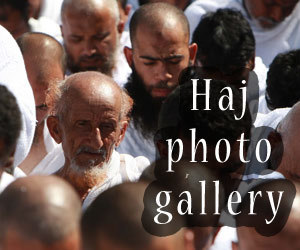A JOURNEY OF FAITH
Haj — the fifth pillar of Islam — is a religious journey to the House of Allah in Makkah. This is in response to the call of Prophet Abraham when Allah commanded him to call mankind to perform Haj. Haj is the largest gathering of Muslims as about three million Muslims from all over the world meet to worship their Lord. All barriers including language, color, class and race are broken.
Haj is compulsory upon every Muslim under the following condition:
1. Islam
2. Maturity
3. Healthy
4. Mentally sound.
5. Security.
6. Enough money to cover the journey and take care of his dependents.
Preparation for Haj:
If one intends to perform Haj, he must consider the following:
1. Intention. Intention is very important in any act of worship, the intention must be for the sake of Allah.
2. It is important for anyone who intends to perform Haj to learn much about it.
3. One must clear his debts, as Haj is not obligatory upon anyone who is in debt. One should not borrow money or use a credit card to buy a ticket to Haj.
4. It is recommended that one settle all disputes between him and anyone he is at loggerheads with.
5. It is also recommended that one write his will and advises his family to fear Allah before he departs.
Women are required to perform Haj in the company of a Mahram, (someone who cannot marry her). Married women should seek the permission of their husbands to perform Haj.
IHRAM:
Ihram is referred to as the two pieces of cloth male pilgrims wear to cover the body, one for the upper part and the other for the lower part. Pilgrims are required to take their Ihram at the Miqaat and start reciting the Talbiya.
TALBIYA:
Talbiya are words of praises pilgrims pronounce in response to Allah's call from the time they take their Ihram till the tenth of Dhul Hijjah. Talbiya, labbaik allahumma labbaik labbaika la shareek lak labbaik innal hamda wanniamata laka wal mulk la shareeka lak is recited aloud.
TAWAF:
Upon reaching Makkah, pilgrims head toward Haram (the House of Allah at Makkah) to make tawaf (circumambulation) round the Kaaba seven times. The top gown of Ihram covers the left shoulder while the right arm is left uncovered.
SA'YIE:
Sa'yie is the seven round of walking and jogging which begins at Safa and ends at Marwa.
EIGHTH OF DUL HIJJAH:
On this day, pilgrims move to Mina reciting Talbiya, at Mina all four rak'ats of compulsory prayers are shortened to two.
NINTH OF DUL HIJJAH:
Pilgrims proceed to Arafat before dhuhr prayer and stay at Arafat until after sunset engaged in supplications. Standing at Arafat is the most important part of the Haj.
Pilgrims proceed to Muzdalifah after sunset repeating the Talbiya and should not perform maghrib prayer at Arafat.
MUZDALIFAH:
Upon reaching Muzdalifah, pilgrims are required to perform maghrib and isha prayers together with one adhan and two iqaamah, Isha prayer is shortened to two.
TENTH OF DUL HIJJAH:
On the tenth of Dul Hijjah, pilgrims perform the subhi prayer and wait until sunrise when they will proceed to Mina. They pick seven pebbles to be thrown at Jamrat Aqaba.
RAMYI AT MINA (TENTH OF DUL HIJJAH):
On the tenth of Dul Hijjah, pilgrims are required to throw seven pebbles at Jamrat Aqaba. The jamrat is only symbol of devil. Pilgrims throw seven pebbles at the Jamrat Aqaba saying Allahu Akbar (Allah is the Greatest) each time a pebble is thrown. After throwing the pebbles, slaughter the sacrificial animal (if needed,) and trim or shave their heads (women however trim their hair) and remove the Ihram but should spend the two or three following nights at Mina until they finish throwing the pebbles.
On the tenth of Dul Hijjah, one must proceed to Makkah and perform Tawaf Al Ifadhah, and return to Mina to spend the night.
ELEVENTH OF DUL HIJJAH:
On the eleventh of Dul Hijjah, pilgrims go to throw pebbles at the three jamrats beginning with the one near Mina, then the second one and the last one which is near Muzdalifah.
TWELFTH OF DUL HIJJAH:
On this day, pilgrims throw seven pebbles as done on the previous day and are free to return to Makkah before sunset.
NOTE: If one however delays until after sunset, he must remain in Mina and throw the pebbles again on the thirteenth and then proceed to Makkah.
TAWAFUL WIDAA:
This is known as farewell tawaf, and it should be done at the last hour before leaving Makkah. If after the tawaf the pilgrim spends another night in Makkah, he or she is required to do the tawaf again.
VISIT TO MADINAH:
A visit to the Prophet Muhammad's Mosque in Madinah is recommended after or before the Haj.



 Your new post is loading...
Your new post is loading...







